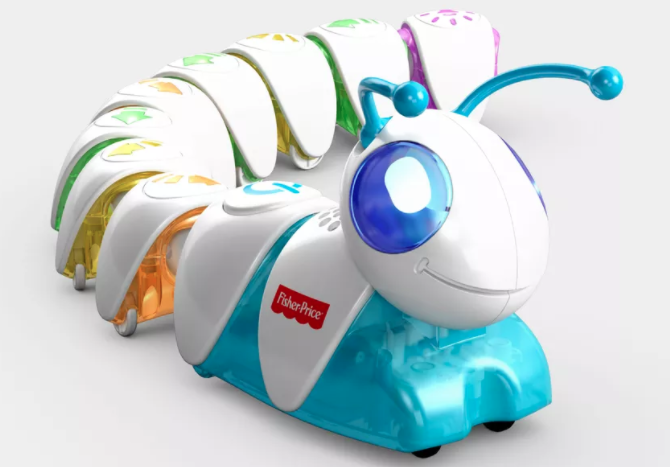
Code-a-Pillar

Overview
The Code-a-Pillar teaches the basics of coding, using sequencing and programming, with segments of the caterpillar's body. Each of the eight segments is labeled with different symbols and colors. The students will put them together, attach them to the caterpillar's smiling, blinky-eyed, motorized head, and press a button to get the whole toy to move.
The students will program the Code-a-Pillar to travel from a starting point to an ending point by plugging in the segments in the correct order.
Learning Objectives
Students will:
- Be able to learn basic coding skills.
- Be able to understand the basic components of computational thinking.
Vocabulary
Vocabulary Words:
- Coding: Coding is writing instructions for a computer to perform.
- Computational Thinker: A computational thinker develops and employs the thought processes involved in formulating a problem and expressing its solution(s) in such a way that a computer-human or machine—can effectively carry out.
Pre-planning
To prepare for this lesson:
- The teacher will purchase a Code-a-Pillar.
- Target, Amazon, Fisher Price and Walmart all sell the Code-a-Pillar for around $40.00- $50.00.
-
Make sure each segment lights to show that it’s connected properly.
-
Additional segments can be purchased that not only turn or go straight but add blinking eyes and special sounds.
-
View the Teacher Guide.
Accommodations
See the Accommodations Page and Charts on the 21things4students website in the Teacher Resources.
Steps
Directions for this activity:
- The teacher will introduce the Code-a-Pillar to the students.
- The students are going to learn basic coding, program solving and criticial thinking skills as they get the Code-a-Pillar to move.
- Have the students play with it at first to learn what it does.
- Then have the students create cards for each segment and then lay them down in order to guide the order segments are attached. This will teach them what goes into basic coding.
- Make sure to give it a lot of space as it makes slow turns.
- Note that the music cannot be turned off.
Additional Activities:
- Have the students create an obstacle course in the classroom.
- Have the students draw a map and have the Code-a-Pillar go to different locations on the map.
Assessment Options
Different options for assessing the students:
- Observations
- Check for understanding
- Create a simple rubric for:
- Maze creation.
- Putting the code-a-pillar through it paces through the obstacle courses.
- Map making skills.
MITECS Competencies & ISTE Standards
MITECS: Michigan adopted the "ISTE Standards for Students" called MITECS (Michigan Integrated Technology Competencies for Students) in 2018.
Computational Thinker
5a. Students formulate problem definitions suited for technology-assisted methods such as data analysis, abstract models and algorithmic thinking in exploring and finding solutions.
5c. Students break problems into component parts, extract key information, and develop descriptive models to understand complex systems or facilitate problem-solving.
5d. Students understand how automation works and use algorithmic thinking to develop a sequence of steps to create and test automated solutions.
Devices and Resources
Device: Code-a-Pillar
Website:
Code-a-Pillar Teacher Guide
CONTENT AREA RESOURCES
ELA
Students can write a short story on the Code-a-Pillar's adventure around the room.
Integrated Arts
The students can build an elaborate obstacle for the Code-a-Pillar to go through.
Math
The students are learning basic coding skills.
Science
The students are learning basic engineering skills.
Social Studies
CREDITS
This task card was created by Andy Mann, REMC Director, Muskegon Area ISD and Melissa White, 21Things Project Manager. Updated October 2023.


